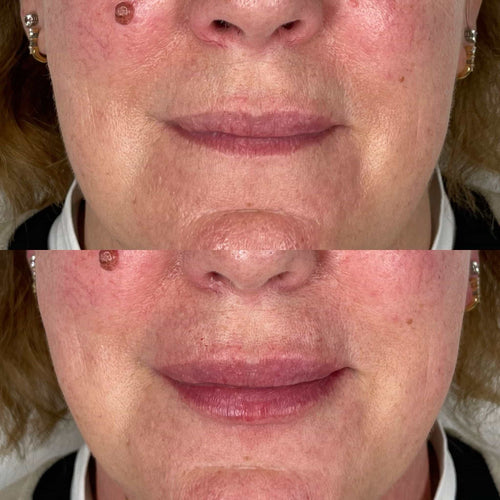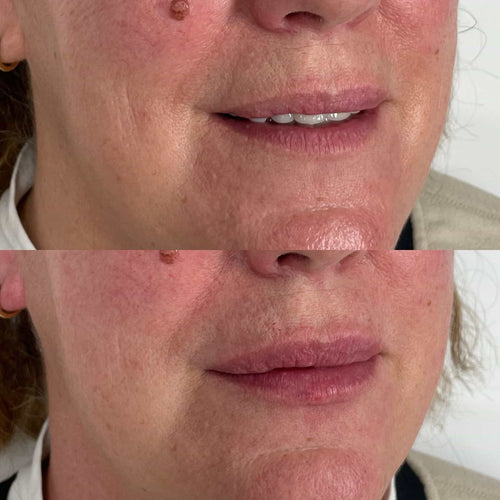Reserve a Dermal Filler Session with Dr. Laura Geige Now
Potential Complications of Temple Filler
Vision Impairment
Temple fillers are a popular cosmetic procedure used to enhance facial contours and create a more defined look. While generally considered safe, there are potential complications associated with any injectable procedure, including vision impairment.
The risk of vision impairment from temple filler injections is relatively rare but should be taken seriously. It typically occurs when the filler product inadvertently migrates into the blood vessels that supply the eye.
This migration can obstruct blood flow to the optic nerve, which carries visual information from the eye to the brain. As a result, it can lead to temporary or, in severe cases, permanent vision loss.
Several factors can increase the risk of this complication, including:
-
Injection into areas too close to the eye
-
Using a filler product that is not specifically designed for facial contouring
-
Incorrect injection technique
-
Underlying medical conditions, such as vascular disease or diabetes
If you experience any sudden changes in vision after receiving temple filler injections, such as blurred vision, double vision, or loss of peripheral vision, seek immediate medical attention. Early diagnosis and treatment can significantly improve the chances of preserving vision.
It’s crucial to choose a qualified and experienced injector who understands the anatomy of the face and the potential risks associated with temple filler injections. Always discuss your medical history and any concerns you may have with your injector before undergoing the procedure.
Secure a Dermal Filler Appointment with Dr. Laura Geige Today
Inflammation and Infection Risks
While temple filler injections are generally considered safe, as with any medical procedure, there are potential complications that can arise.

One serious concern is **inflammation**. Inflammation at the injection site is common and usually mild, but it can occasionally become severe. Severe inflammation can lead to tissue damage and potentially affect vision if it involves blood vessels in the eye area.
Another major risk is **infection**. Any time a needle penetrates the skin, there’s a risk of introducing bacteria into the body. Infections associated with filler injections are rare but can be serious if not treated promptly.
Less common complications include:
-
**Vascular occlusion:** This occurs when a blood vessel is blocked by the injected filler. If it affects a blood vessel supplying the eye, it could potentially lead to vision problems or loss of vision.
-
**Allergic reaction:** Although rare, some people may have an allergic reaction to the filler material.
-
Asymmetry: If the injections are not performed evenly, it can result in asymmetry in the temples.
It is crucial to choose a qualified and experienced injector who uses sterile techniques and high-quality filler products. Before undergoing any injectables procedure, discuss your medical history, potential risks, and alternatives with your doctor.
Understanding Temple Fillers
What Are They?
Temple fillers are injectable cosmetic substances used to augment or reshape the temples, a common concern for those seeking facial rejuvenation. They aim to address volume loss and create a more youthful, defined look.
The most popular temple filler is hyaluronic acid (HA), a naturally occurring substance in the body that provides hydration and plumpness. HA fillers are temporary, typically lasting 6-18 months depending on the individual and product used.
Other types of fillers include calcium hydroxylapatite and poly-L-lactic acid (PLLA), which offer longer-lasting results.
Temple fillers are administered through a series of injections by a qualified medical professional, typically a dermatologist, plastic surgeon, or aesthetic nurse practitioner. They use fine needles to inject the filler strategically into the temple area.
The procedure is generally considered safe when performed by an experienced and licensed provider. However, as with any injection-based cosmetic treatment, there are potential risks and complications.
Book a Dermal Filler Consultation at It’s Me and You Clinic with Dr. Laura Geige
How Do They Work?
Temple fillers are a popular cosmetic treatment used to augment and contour the temples, adding volume and definition to the face.
They work by injecting hyaluronic acid (HA) gel under the skin.

Hyaluronic acid is a naturally occurring substance in the body that helps to hydrate and plump the skin.
When injected into the temples, HA filler adds volume and fullness, creating a more youthful and balanced appearance.
Here’s a more detailed breakdown of how temple fillers work:
-
Injection Process: A qualified injector will use a fine needle to carefully deposit the HA gel into the targeted areas of the temples.
-
Volume and Lift: The HA filler adds volume to the temple area, creating a more prominent and defined contour.
-
Lifting Effect: By adding volume, the fillers can also subtly lift the brow and create a more youthful eyebrow arch.
-
Hydration and Plumping: HA attracts water molecules, which helps to hydrate the skin in the treated area, resulting in a smoother and plumper appearance.
Temple fillers are generally considered a safe and effective treatment when performed by a qualified and experienced professional.
However, as with any cosmetic procedure, there are potential risks and complications that should be discussed with the injector beforehand.
Addressing Concerns About Blindness
Scientific Evidence
Addressing concerns about blindness after cosmetic procedures like temple filler injections is crucial for patient safety and informed decision-making.
While rare, vision complications can occur following any medical procedure involving facial injectables. This risk stems from potential complications such as vascular occlusion (blockage of blood vessels) or allergic reactions.
In the case of temple filler injections, concerns arise because the area is close to vital blood vessels supplying the eye. If a filler product inadvertently enters these vessels, it can lead to blockage and potentially compromise blood flow to the retina, the light-sensitive tissue at the back of the eye. This can result in vision loss or even blindness.
Scientific evidence regarding the exact frequency of blindness caused by temple filler is limited. Large-scale studies specifically investigating this complication are scarce. However, anecdotal reports and case studies do exist documenting cases of vision impairment or loss following facial injectables, including those placed in the temple area.
It’s essential to emphasize that these cases are not necessarily directly attributable to temple filler alone. Pre-existing conditions, individual patient factors, or procedural complications can contribute to such outcomes.
To mitigate risks associated with any cosmetic procedure, patients should consult experienced and board-certified physicians who have extensive knowledge of facial anatomy and injectables. Thorough pre-procedure assessments, including medical history review and allergy testing, are crucial for identifying potential risks and ensuring patient safety.
Patients should also be fully informed about potential complications, both common and rare, before undergoing any procedure. Open communication with the physician and clear understanding of the risks and benefits are essential for making informed decisions about cosmetic treatments.
Expert Opinions
Concerns regarding blindness stemming from temple filler injections have surfaced, prompting discussion and investigation within the medical community.
It’s crucial to understand that while complications can arise with any medical procedure, including injectables like dermal fillers, blindness directly caused by temple filler is extremely rare.
Blindness**, in this context, usually refers to a serious condition known as **optic nerve ischemia**. This occurs when blood flow to the optic nerve, responsible for transmitting visual information from the eye to the brain, is interrupted.
While filler injections can theoretically block blood vessels, leading to ischemic events, this complication is highly unlikely if proper injection techniques are followed.
Expert opinions emphasize that reputable practitioners meticulously assess patient medical history and perform injections with precision, avoiding the proximity of major blood vessels near the optic nerve.
Nevertheless, any injection carries a potential for complications, even when performed by skilled professionals. It is vital to choose a board-certified plastic surgeon or dermatologist with extensive experience in injecting dermal fillers.
Patients should always undergo a thorough consultation before any procedure. Discuss any pre-existing medical conditions, medications, and concerns about potential risks with the practitioner.
In rare instances where vision changes occur after temple filler injections, seeking immediate medical attention is crucial to minimize any potential damage.
Democracy Defense Coalition Making Memories London Emily Patricia Fae Line the Studio Live Your Vows Dr. Nerina Muses
- Traptox Aka Trapezius Botox Treatment Near Virginia Water, Surrey - January 5, 2025
- Skin Pen Microneedling Near Tilford, Surrey - January 4, 2025
- Skin Pen Microneedling Near Ewell, Surrey - January 4, 2025
